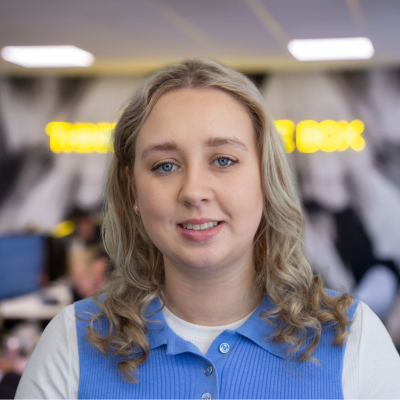Inside the Classroom: A Day in the Life of a SEND Teacher
21 Mar, 20241-2 minutes
In this blog, you will learn:
- What a typical day is like for a SEND Teacher in the classroom.
- How the role of a SEND Teacher differs in a mainstream school compared to a special education school.
- Where the best SEND Teacher jobs are and how to find them.
SEND Teachers play a pivotal role in shaping the lives of children and young people with Special Educational Needs and Disabilities (SEND). Managing and addressing behaviours effectively while encouraging a positive and inclusive classroom environment means the role of a SEND Teacher can be extremely challenging at times.
However, there are also many positive benefits to being a SEND Teacher and we recently caught up with one of them, Shaun, to see how he finds working in a specialist school.
From volunteering and working in a mainstream school, to working as a Social Emotional and Mental Health (SEMH) Team Leader, Shaun has worked tirelessly in the SEND sector to become an invaluable SEND Teacher.
Shaun’s passion for inclusion, SEND and managing behaviour in the classroom has empowered him to better the lives of children and young people with SEND.
We’ll take a look inside the classroom and discover what it’s really like to be a SEND Teacher and the importance of understanding the individual needs of all students, whether it's in a mainstream or a special education school.
Tell us about your career journey so far
Thank you for this opportunity to speak about my teaching career and roles. I'm very passionate about my job and I hope that this shows what it is like.
Teaching wasn't always on my radar. I graduated with a degree in Economics and Geography. The plan was always to go into some sort of finance or corporate role. I did work for a recruitment management firm for a while but I couldn't get comfortable sitting at a desk all day. I then did some volunteering in a primary school, working as a sports coach and then subsequently a Teaching Assistant.
Fast forward to my first teaching job, I worked in a large inner city Leeds primary school. I loved this school! It was so diverse with many different and challenging layers. My interest in behaviour and inclusion was born here and I started an alternative provision at this school. I ran it for about 3 years and I hear that the provision has transformed into a brilliant space for learners with Special Educational Needs and Disabilities (SEND).
I did work in another mainstream school for a little while but wanted to find a role in a specialist education setting. I feel grateful that I'm now working as a Special Educational Needs and Disabilities (SEND) Teacher. I love my class and have enjoyed getting to know them.
What does your role as a SEND Teacher consist of?
The role of a SEND Teacher is very diverse and there are so many differences working as a SEND Teacher compared to a mainstream education Teacher. Some of the main differences between SEND Teachers and Teachers are:
- SEND Teachers have additional staff in order to support students in the classroom.
- SEND Teachers have access to more resources such as sensory rooms.
- SEND Teachers have on site teams available such as communication teams and experts on hand to support them.
- SEND Teachers have more time and space to create more personalised learning experiences (they sort of have to in order to better support children and young people with SEND).
My current role isn't too dissimilar to running the alternative provision. My longer term objectives include working on Educational Health Care Plan (EHCP) targets, holding annual review meetings as well as updating individual support plans.
What does a typical day look like for you?
Essentially, my timetable doesn’t change all that much primarily because we want to keep things fairly predictable for the students.
A typical school day for me would look like this:
8.30am: Arrive at school and set up resources for the school day ahead.
9:10am: Students start to arrive. To begin, they'll have slow starting activities to complete. Some students complete sensory circuits, and some will go outside for a bit but generally we try to keep this time relaxed to prepare for the day ahead.
9:45-11am: This period of time consists of phonics and playtime. Playtime is generally about 25 minutes.
11-12pm: Maths. Maths can be quite flexible with students completing different activities to achieve different targets. Some of my students will go to the sensory room and complete some of their targets there.
12-1pm: Lunch time!
1-3pm: In the afternoon, we'll complete our topic based activities. These range from art and crafts, cooking and horticulture, to PE and swimming. There is also time for students to complete sensory based activities.
3pm- Home time!
How do you keep up-to-date with changes in the SEND industry?
To be honest, I find myself chatting and collaborating with other content creators and Teachers. Reading the SEN magazine is very informative. LinkedIn is also a very good place to speak to other Teachers in this area. For more practical strategies and activities for the classroom, I usually head to Pinterest.
What have you learned so far in your career?
I've learned that education as a whole is a forever changing landscape and as educators, we have a very important role to play within that system.
What obstacles have you had to face in your career?
I would say that particularly over the last few years I have prioritised managing my workload. This has definitely given me a better work life balance.
How have things changed or progressed in the education and SEND industry?
I think that the education system as a whole has changed dramatically over the last few years. Education has always been a particularly political tool and so many different teaching strategies and trends have come and gone.
Within the SEND industry, educators and other professionals have become much better at identifying needs and putting appropriate support in place for students and young people with SEND. This has certainly meant that more students are having their needs met. However, there is still a long way to go in this area, particularly in mainstream education.
What do you feel can be done to support the needs of pupils with SEND?
One key aspect of this is to take the time as an educator to learn about the needs of the students in your classroom. Being curious about inclusion and behaviour will give educators the time and space to appropriately support our SEND students.
I do think educators in mainstream education need more training on how to support their SEND students. This is primarily due to the fact that in most mainstream classes you will have over 30 students, and these can include pupils with SEND.
Do you have any tips or advice for someone wanting to become a SEND Teacher?
Being a SEND Teacher is an incredible experience and so if someone is looking to go in that direction I would encourage them to read as much as they can about behaviour and inclusion.
If possible, visit different educational settings. It can be a very helpful way to understand how specialist educational settings are structured.
If you're interested in the SEND sector, and you work in a mainstream school, it could be valuable to speak to your SENCO and discuss different ways that you can support the SEND students in your class.
What are your plans for the future?
I'm currently focusing on being the best SEND Teacher that I can be. This includes reading a lot about different strategies, collaborating with different Teachers and immersing myself in a different educational setting.
I also really enjoy creating content and resources for Teachers to support them with their students. This is an ongoing project of mine, so watch this space!
We’d like to extend our thanks to Shaun for taking the time out of his busy schedule to complete this interview.
SEND Teacher jobs
Looking for your dream SEND Teacher job? The search is over! We work with a variety of mainstream and SEND schools across the North West who are looking to hire the best talent for their schools.
Check out what roles we have available now or upload your CV and one of our specialist education consultants will be in touch when a relevant opportunity becomes available.
Love this content? You might also like:
- How to write a standout SEND Teacher CV.
- 3 tips to write the perfect SEND Teacher cover letter.
- What questions do they ask in a SEND Teacher interview?
Recruiting SEND Teachers?
As a leading SEND recruitment agency, we support countless mainstream and SEND schools with their recruitment needs. If you’re struggling to fill a SEND Teacher vacancy, why not give our Managing Consultant, Jamie Heath, a call on 01772 954200 to discover how we can assist the needs of your school.
Share your experience
Every individual brings a unique set of experiences, thoughts, and insights to the table. We believe in giving a voice to a community of professionals to inspire positive change and champion reform in the education sector.
If you work in the education sector and would like to share your own personal and professional experiences, we’d love to hear from you. Perhaps you have a different perspective, could offer a fresh angle, or want to challenge assumptions.
Simply reach out to our Head of Content, Nicole Sherwood, to discuss a collaboration which makes your voice count.
Meet Jamie Heath
Who is Spencer Clarke Group?
Formed in 2017, we are a specialist public and private recruitment agency that has pushed the boundaries to revolutionise not only the way we do business, but also the recruitment industry. We are at the forefront of innovation and have a passion for creating positive change and prioritising our candidates and clients needs.
We operate in two sectors:
In eleven specialisms:
Healthcare, Social Care & Nursing
Corporate Functions & Business Support




